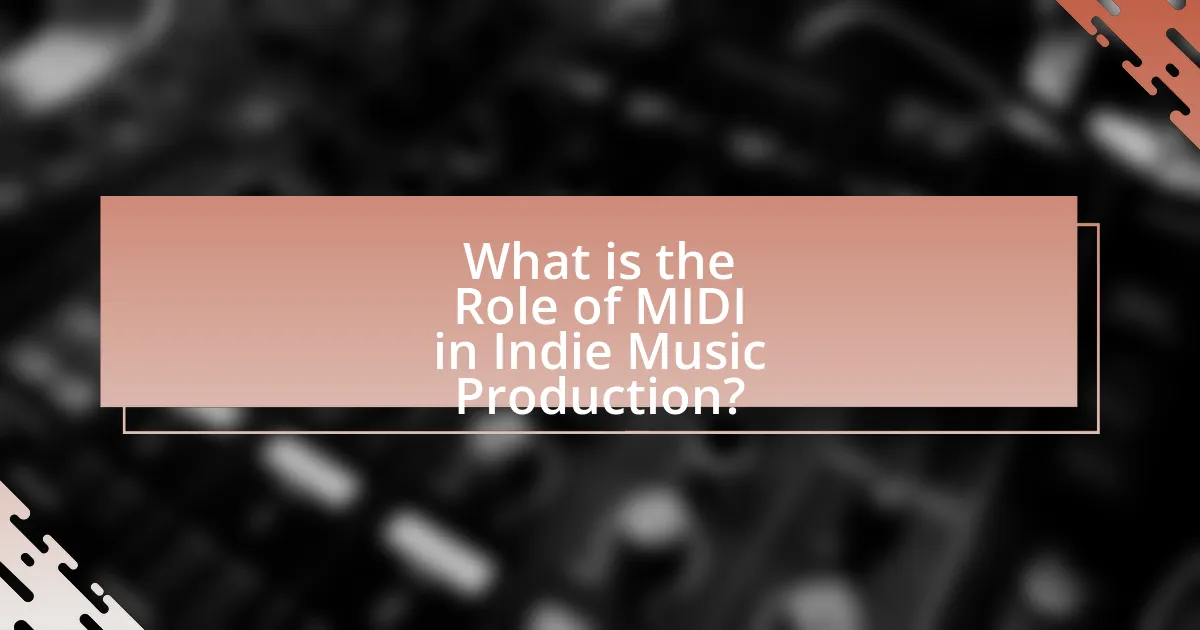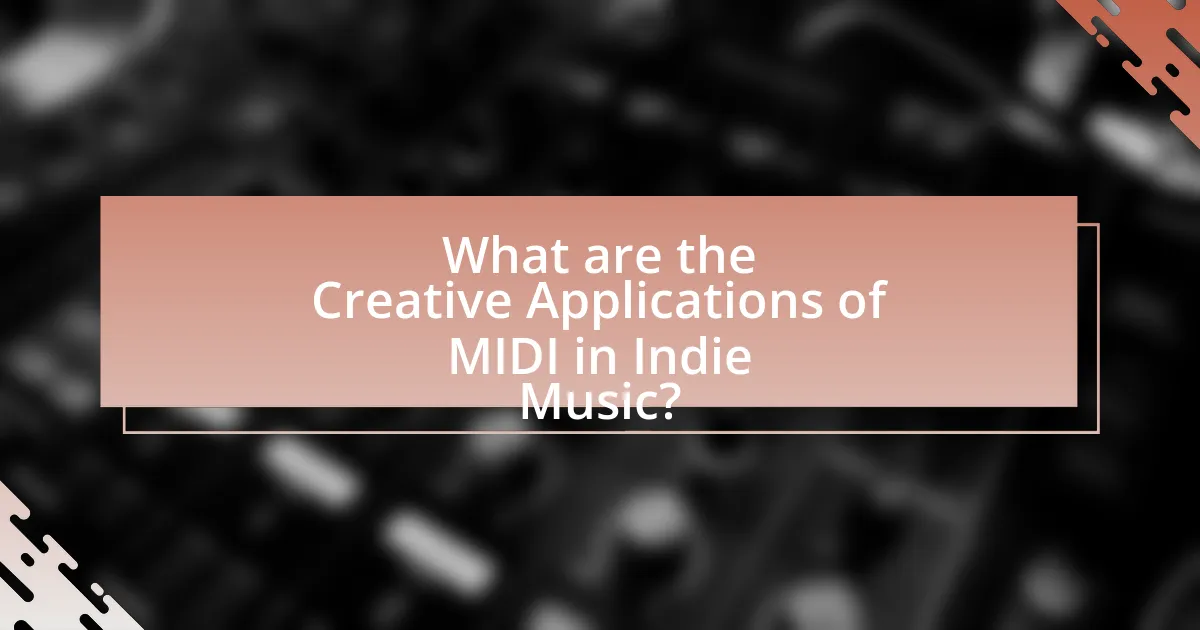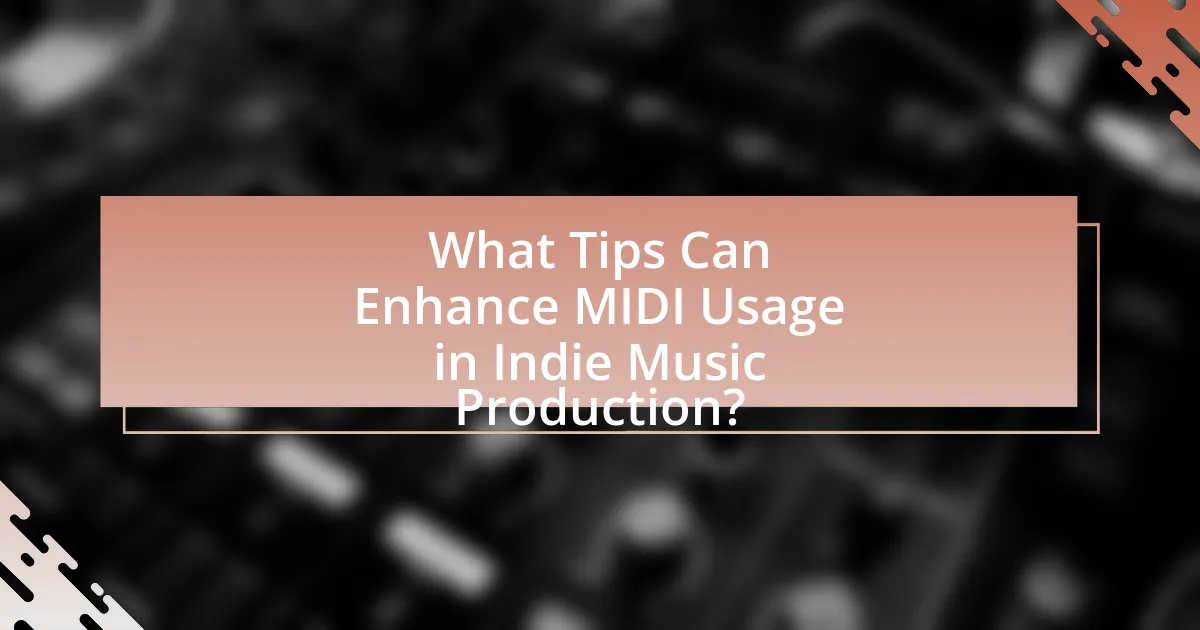The article focuses on the role of MIDI (Musical Instrument Digital Interface) in indie music production, highlighting its significance in enabling musicians to create, edit, and manipulate compositions with precision and flexibility. It discusses how MIDI technology functions, its key components, and its communication with digital audio workstations (DAWs). The article also explores the advantages of MIDI for indie producers, including its impact on composition and arrangement, creative applications, and techniques for enhancing music production. Additionally, it provides tips for effectively integrating MIDI into workflows, troubleshooting common issues, and utilizing advanced techniques to foster creativity in music composition.

What is the Role of MIDI in Indie Music Production?
MIDI plays a crucial role in indie music production by enabling musicians to create, edit, and manipulate musical compositions with precision and flexibility. This technology allows artists to control virtual instruments and synthesizers, facilitating the arrangement of complex musical ideas without the need for extensive recording equipment. For instance, MIDI data can be easily adjusted for timing, pitch, and dynamics, which enhances the creative process and allows for rapid experimentation. Additionally, MIDI’s compatibility with various digital audio workstations (DAWs) streamlines the workflow for indie producers, making it accessible for those with limited budgets or resources.
How does MIDI technology function in music creation?
MIDI technology functions in music creation by transmitting digital signals that represent musical notes and performance data between devices. This allows musicians to compose, edit, and playback music using various instruments and software without the need for audio recordings. MIDI data includes information such as pitch, velocity, and duration, enabling precise control over sound production. The widespread adoption of MIDI since its introduction in 1983 has facilitated collaboration across different platforms and devices, making it a fundamental tool in modern music production.
What are the key components of MIDI technology?
The key components of MIDI technology include MIDI messages, MIDI channels, and MIDI devices. MIDI messages are the data packets that convey information about musical performance, such as note on/off, pitch, and velocity. MIDI channels allow for the transmission of multiple signals over a single connection, enabling the control of different instruments or sounds simultaneously. MIDI devices, which include controllers, synthesizers, and computers, facilitate the creation, manipulation, and playback of MIDI data. These components work together to enable musicians to compose and produce music efficiently, making MIDI a fundamental technology in music production.
How does MIDI communicate with digital audio workstations?
MIDI communicates with digital audio workstations (DAWs) by transmitting digital signals that represent musical notes and performance data. This communication occurs through MIDI messages, which include note on/off, velocity, pitch bend, and control changes, allowing DAWs to interpret and reproduce musical performances. MIDI operates over various connections, such as USB or traditional 5-pin DIN connectors, enabling seamless integration with software instruments and hardware synthesizers. The MIDI protocol, established in the early 1980s, standardizes this communication, ensuring compatibility across different devices and software, which is essential for modern music production workflows.
Why is MIDI important for indie music producers?
MIDI is important for indie music producers because it allows for precise control over musical elements and facilitates the creation of complex compositions. By using MIDI, producers can easily manipulate notes, rhythms, and dynamics, enabling them to experiment with different sounds and arrangements without the need for expensive hardware. Additionally, MIDI supports a wide range of virtual instruments and software, which are often more accessible and affordable for indie artists. This flexibility and affordability empower indie music producers to produce high-quality music that can compete in the industry.
What advantages does MIDI offer for composition and arrangement?
MIDI offers significant advantages for composition and arrangement by providing flexibility, precision, and ease of editing. This digital protocol allows musicians to create, modify, and arrange music using virtual instruments and software, enabling real-time playback and instant adjustments. For instance, MIDI data can be easily manipulated to change notes, dynamics, and timing without the need for re-recording, which streamlines the creative process. Additionally, MIDI supports a wide range of instruments and sounds, allowing composers to experiment with different textures and styles efficiently. This versatility is crucial in indie music production, where innovation and experimentation are often key to developing a unique sound.
How does MIDI enhance the creative process in indie music?
MIDI enhances the creative process in indie music by providing musicians with flexible tools for composition and arrangement. This technology allows artists to easily manipulate musical elements such as pitch, duration, and dynamics, enabling rapid experimentation with different sounds and structures. For instance, MIDI’s ability to control virtual instruments and synthesizers facilitates the creation of complex arrangements without the need for extensive recording equipment. Additionally, MIDI data can be edited non-destructively, allowing for quick adjustments and iterations, which is crucial in the often time-sensitive indie music production environment. This adaptability supports a more fluid creative workflow, empowering indie musicians to explore innovative ideas and refine their compositions efficiently.

What are the Creative Applications of MIDI in Indie Music?
Creative applications of MIDI in indie music include the use of virtual instruments, automation of effects, and the creation of complex arrangements. Indie musicians leverage MIDI to access a wide range of sounds and textures that may not be available through traditional instruments, allowing for innovative compositions. For instance, MIDI enables the layering of multiple tracks, facilitating intricate harmonies and rhythms that enhance the overall sound. Additionally, MIDI’s ability to automate parameters such as volume, panning, and effects processing allows artists to create dynamic and evolving soundscapes. This versatility is evidenced by the increasing use of MIDI in indie music production, where artists often experiment with unconventional sounds and arrangements to define their unique style.
How can MIDI be used to create unique sounds?
MIDI can be used to create unique sounds by allowing musicians to manipulate digital instruments and effects in precise ways. Through MIDI, users can control parameters such as pitch, velocity, and modulation, enabling the creation of distinctive timbres and textures. For instance, by layering multiple MIDI tracks with varying instrument settings and effects, artists can generate complex soundscapes that are not achievable with traditional instruments alone. Additionally, MIDI’s ability to integrate with software synthesizers and samplers allows for extensive customization, further enhancing the uniqueness of the sounds produced.
What types of MIDI instruments can be utilized in indie music?
MIDI instruments utilized in indie music include synthesizers, drum machines, and MIDI controllers. Synthesizers provide a wide range of sounds and textures, allowing artists to create unique sonic landscapes. Drum machines offer programmable beats that can enhance the rhythmic foundation of a track. MIDI controllers, such as keyboards and pads, enable musicians to manipulate virtual instruments and software, facilitating creative expression in the production process. These instruments are integral to indie music, as they allow for experimentation and innovation in sound design.
How can MIDI effects shape the sound of a track?
MIDI effects can significantly shape the sound of a track by altering the MIDI data before it reaches the instrument. These effects can include arpeggiators, chord generators, and note repeaters, which modify the pitch, timing, and velocity of notes, thereby influencing the overall musical expression. For instance, an arpeggiator can create complex rhythmic patterns from simple chords, enhancing the track’s texture and movement. Additionally, MIDI effects can introduce variations in dynamics and articulation, allowing for more expressive performances. This capability is crucial in indie music production, where unique sound design often distinguishes a track.
What techniques can indie producers use with MIDI?
Indie producers can utilize various techniques with MIDI, including quantization, layering, and automation. Quantization allows producers to correct timing issues by aligning MIDI notes to a grid, enhancing rhythmic precision. Layering involves combining multiple MIDI tracks to create richer sounds, which can be achieved by stacking different instruments or sounds. Automation enables dynamic changes in MIDI parameters, such as volume and effects, throughout a track, adding depth and interest. These techniques are widely used in music production to enhance creativity and improve the overall quality of compositions.
How can layering MIDI tracks enhance a composition?
Layering MIDI tracks enhances a composition by adding depth and richness to the sound. This technique allows for the combination of different instruments and sounds, creating a fuller auditory experience. For instance, layering a piano track with strings can produce a more complex harmonic texture, which engages listeners more effectively. Additionally, using multiple MIDI tracks enables composers to experiment with dynamics and timbres, leading to unique sonic landscapes that can evoke various emotions. Studies in music production have shown that well-layered tracks can significantly improve the overall quality and appeal of a piece, making it more memorable and impactful.
What role does MIDI automation play in production?
MIDI automation plays a crucial role in music production by allowing producers to control various parameters of virtual instruments and effects over time. This capability enables dynamic changes in volume, panning, modulation, and other effects, enhancing the expressiveness and complexity of a track. For instance, automation can create gradual volume swells or intricate filter sweeps, which contribute to the overall emotional impact of a piece. The use of MIDI automation is supported by its integration in digital audio workstations (DAWs), where producers can visually edit automation curves, making it easier to achieve precise control over sound elements.

What Tips Can Enhance MIDI Usage in Indie Music Production?
To enhance MIDI usage in indie music production, musicians should focus on utilizing MIDI effects, experimenting with different instruments, and incorporating automation. MIDI effects, such as arpeggiators and chord generators, can add complexity and variation to compositions, making them more engaging. Experimenting with a wide range of virtual instruments allows for unique soundscapes, which is crucial in the indie genre known for its diversity. Additionally, incorporating automation in MIDI tracks can create dynamic changes in volume, panning, and effects, leading to a more polished and professional sound. These strategies are supported by the fact that many successful indie artists leverage MIDI to create intricate arrangements and distinctive sonic identities.
How can producers effectively integrate MIDI into their workflow?
Producers can effectively integrate MIDI into their workflow by utilizing MIDI controllers for real-time performance and composition, which enhances creativity and efficiency. By employing MIDI controllers, producers can manipulate virtual instruments and software synthesizers directly, allowing for expressive playing and immediate feedback. Additionally, using MIDI sequencing software enables precise editing of note data, facilitating intricate arrangements and adjustments. Studies show that incorporating MIDI in music production can significantly streamline the creative process, as it allows for easy experimentation with different sounds and arrangements without the need for extensive recording sessions.
What best practices should be followed when using MIDI?
When using MIDI, best practices include organizing tracks effectively, utilizing quantization for timing accuracy, and employing MIDI effects to enhance creativity. Organizing tracks allows for easier navigation and editing, which is crucial in complex projects. Quantization ensures that notes align perfectly with the grid, improving the overall timing of the composition. Additionally, using MIDI effects such as arpeggiators or chord generators can inspire new ideas and add depth to the music. These practices are supported by industry standards, as many successful producers emphasize the importance of organization and timing in their workflows.
How can troubleshooting common MIDI issues improve production quality?
Troubleshooting common MIDI issues can significantly enhance production quality by ensuring accurate communication between devices and software. When MIDI data is correctly transmitted, it prevents timing errors, note dropouts, and latency, which can detract from the overall sound. For instance, resolving issues like incorrect MIDI channel settings or faulty connections can lead to a more cohesive and polished final mix. Additionally, addressing these problems allows for better control over virtual instruments and effects, enabling producers to achieve their desired sound more effectively. This technical precision is crucial in indie music production, where the quality of each element can impact the listener’s experience.
What are some creative composition tips for using MIDI?
To enhance creativity in MIDI composition, utilize layering by combining multiple MIDI tracks with different instruments to create a rich sound texture. This technique allows for the exploration of various timbres and harmonies, which can lead to unique musical ideas. Additionally, experiment with MIDI effects such as arpeggiators and chord generators to introduce unexpected rhythmic and harmonic variations, thereby expanding the compositional palette. Furthermore, applying automation to MIDI parameters, like velocity and modulation, can add dynamic expression and nuance to the performance, making it more engaging. These methods are supported by the versatility of MIDI, which enables precise control over musical elements, allowing composers to innovate and refine their compositions effectively.
How can experimenting with MIDI patterns lead to innovative music?
Experimenting with MIDI patterns can lead to innovative music by allowing musicians to explore unconventional rhythms, melodies, and harmonies that may not emerge through traditional composition methods. This exploration enables artists to break free from standard musical structures, fostering creativity and originality. For instance, the use of MIDI allows for rapid iteration and manipulation of musical ideas, which can result in unique soundscapes and unexpected combinations. Additionally, studies have shown that artists who utilize MIDI technology often produce more diverse and experimental works, as they can easily modify parameters such as tempo, pitch, and instrumentation, leading to fresh musical expressions.
What resources are available for learning advanced MIDI techniques?
Online courses, tutorials, and books are key resources for learning advanced MIDI techniques. Platforms like Coursera and Udemy offer specialized courses that cover complex MIDI programming and manipulation. Additionally, YouTube channels such as ADSR Music Production provide free video tutorials that delve into advanced MIDI concepts. Books like “MIDI Power!” by Mike Collins serve as comprehensive guides, detailing intricate MIDI applications. These resources collectively enhance understanding and application of advanced MIDI techniques in music production.


